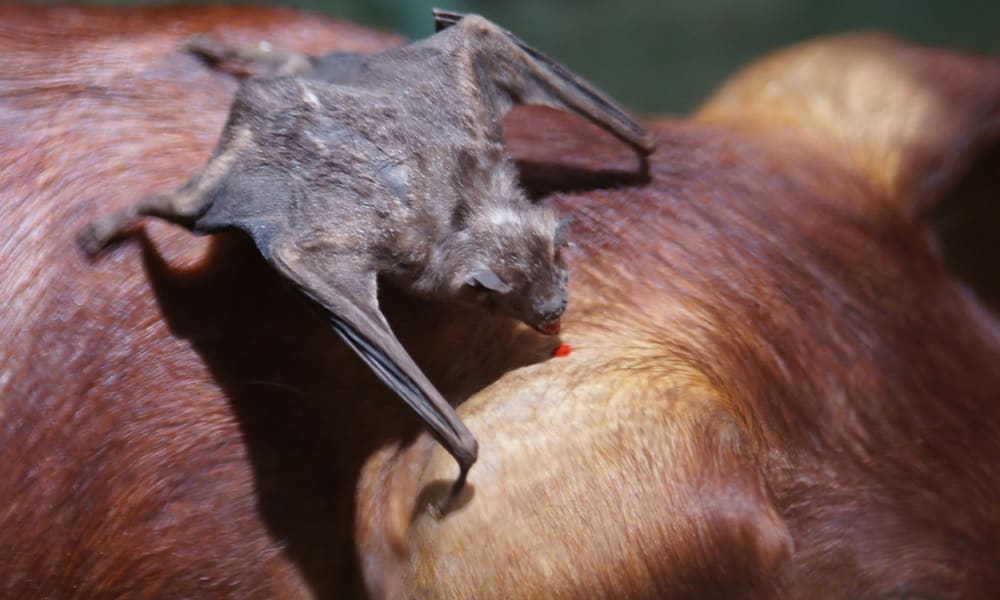There are three species of vampire bats in the entire world – the common vampire bat, the white-winged vampire bat and the hairy-legged vampire bat – and good news! – they all live in Costa Rica.
Alright folks, put on your big kid pants for this article. While all of nature’s creations are wonderful in their own way, all fitting into a niche, carrying out all of the activities that need to be done to pass their genes on to the next generation, some creatures are just a little bit creepier than others. It’s hard to argue that vampire bats don’t fit into the creepy column.
They drink blood from unsuspecting, often sleeping, animals. Their flattened, toothy faces can easily be described as terrifying (I recommend not Googling them). Heck, even their locomotion is eerie. Even though most things about them are unnerving, they still play an important role in the ecology of the forests that we love in Costa Rica. So let’s learn about vampire bats.
We’re going to focus on the common vampire bat (Desmodus rotundus), but first let’s mention the lesser-known white-winged vampire bat (Diaemus youngi) and hairy-legged vampire bat (Diphylla ecaudata).
These two species spend their days in similar places to most bats, in hollow trees or caves. What makes them special is what they’re looking for when they venture out at night – bird blood. Both species specialize in feeding on birds.
Their move is to approach sleeping birds on the underside of the branch that they’re roosting on and bite them on the feet or anus and lap up their meal. I know. The whole article is going to be like this.
Onto the common vampire bat. Let’s start with their method of feeding. In our nightmares, vampire bats suck the blood out of their unsuspecting victims. While in reality, they use their razor-sharp incisors to cut a shallow 5 to 8mm slice into their prey and use the grooves in the underside of their tongue to draw out the blood through capillary action.
They are aided by anticoagulants in their saliva that can keep blood flowing from the wound for up to eight hours after feeding. I’m not sure if all of that is less creepy than sucking blood from their prey, but at the very least it’s more accurate.
We now know that the two lesser-known species prefer bird blood, so what about the common vampire bat? They too are willing to take a bite out of birds, but their palate includes wild mammals, people and livestock. Their main prey are livestock, but I threw ‘people’ in there, so let’s talk about that.
Apparently, on the rare occasions that they feed on people, they find one person that they prefer out of a group of people, and they’ll return to feed on that person several nights in a row while leaving the others alone. Yikes.
The good news is that’s rare. They’re mostly interested in cattle. They come out on nights with little moonlight, usually following streams, until they find a herd of sleeping cattle.
They land nearby, then do a disturbing spider-like hop-crawl over to their cow of choice and seek out an area with little hair, like the neck, ears or … (you can only type anus so many times in a Tico Times article) and settle in to feed. They focus on feeding on cattle so much that they can have unnaturally high populations near cattle ranches, but they are uncommon in pristine environments.
Since I try to avoid recording cattle with my camera traps (sometimes unsuccessfully), I have only recorded common vampire bats feeding on or pursuing their wild prey. I’ve recorded them on or next to white-tailed deer, collared peccaries and Baird’s tapirs. So take a deep breath and click on the video below and get to know the common vampire bat.
About The Author
Vincent Losasso, founder of Guanacaste Wildlife Monitoring, is a biologist who works with camera traps throughout Costa Rica. Learn more about his projects at: Instagram and facebook or by email.






